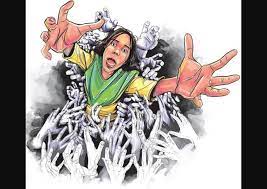Rape is the fourth most common crime against women in India.[1][2] According to the 2021 annual report of the National Crime Records Bureau (NCRB), 31,677 rape cases were registered across the country, or an average of 86 cases daily, a rise from 2020 with 28,046 cases, while in 2019, 32,033 cases were registered.[3] Of the total 31,677 rape cases, 28,147 (nearly 89%) of the rapes were committed by persons known to the victim.[4] The share of victims who were minors or below 18 – the legal age of consent – stood at 10%.[4]
The government also classifies consensual sex committed on the false promise of marriage as rape.[5] Most rapes go unreported in India, although the willingness to report rapes may have increased in recent years,[when?] after several incidents received widespread media attention and triggered local and nationwide public protests.[6][7][8][9] This led the government to reform its penal code for crimes of rape and sexual assault.[10]
According to NCRB 2021 statistics, Rajasthan reported the highest number of rapes among Indian states, followed by Madhya Pradesh and Uttar Pradesh. Among metropolitan cities, the national capital of Delhi continued to have the highest incidence of rape at 1,226 cases in 2021, while Jaipur had the highest rape rate (34 per 100,000 population). Kolkata had the least number of registered rape cases among metropolitan cities, with the lowest rape rate.[4]
Definition in Indian Penal Code

Before 3 February 2013, Section 375 of the Indian Penal Code defined rape as:[13]
§375. Rape. A man is said to commit “rape” who, except case hereinafter excepted, has sexual intercourse[14] with a woman in circumstances falling under any of the six following descriptions:––
Firstly. –– Against her will.
Secondly. –– Without her consent.
Thirdly. –– With her consent, when her consent has been obtained by putting her or any person in whom she is interested, in fear of death or of hurt.
Fourthly. –– With her consent, when the man knows that he is not her husband, and that her consent is given because she believes that he is another man to whom she is or believes herself to be lawfully married.
Fifthly. –– With her consent, when, at the time of giving such consent, by reason of unsoundness of mind or intoxication or the administration by him personally or through another of any stupefying or unwholesome substance, she is unable to understand the nature and consequences of that to which she gives consent.
Sixthly. –– With or without her consent, when she is under sixteen[15] years of age.
Explanation. –– Penetration is sufficient to constitute the sexual intercourse necessary to the offence of rape.
Exception. –– Sexual intercourse by a man with his own wife, the wife not being under fifteen years of age[a], is not rape.
The above definition excluded marital rape, same sex crimes and considered all sex with a minor below the age of sixteen as rape.
After 3 February 2013, the definition was revised through the Criminal Law (Amendment) Act 2013, which also raised the legal age of minors to eighteen.[16]
§375. A man is said to commit “rape” if he:–– (a) penetrates his penis, to any extent, into the vagina, mouth, urethra or anus of a woman or makes her to do so with him or any other person; or (b) inserts, to any extent, any object or a part of the body, not being the penis, into the vagina, the urethra or anus of a woman or makes her to do so with him or any other person; or (c) manipulates any part of the body of a woman so as to cause penetration into the vagina, urethra, anus or any part of body of such woman or makes her to do so with him or any other person; or (d) applies his mouth to the vagina, anus, urethra of a woman or makes her to do so with him or any other person, under the circumstances falling under any of the following seven descriptions:
Firstly. –– Against her will.
Secondly. –– Without her consent.
Thirdly. –– With her consent, when her consent has been obtained by putting her or any person in whom she is interested, in fear of death or of hurt.
Fourthly. –– With her consent, when the man knows that he is not her husband and that her consent is given because she believes that he is another man to whom she is or believes herself to be lawfully married.
Fifthly. –– With her consent when, at the time of giving such consent, by reason of unsoundness of mind or intoxication or the administration by him personally or through another of any stupefying or unwholesome Substance, she is unable to understand the nature and consequences of that to which she gives consent.
Sixthly. –– With or without her consent, when she is under eighteen years of age.
Seventhly. –– When she is unable to communicate consent.
Explanation 1. –– For the purposes of this section, “vagina” shall also include labia majora.
Explanation 2. –– Consent means an unequivocal voluntary agreement when the woman by words, gestures or any form of verbal or non-verbal communication, communicates willingness to participate in the specific sexual act;
Provided that a woman who does not physically resist to the act of penetration shall not by the reason only of that fact, be regarded as consenting to the sexual activity. Exceptions –– 1. A medical procedure or intervention shall not constitute rape; 2. Sexual intercourse or sexual acts by a man with his own wife, the wife not being under fifteen years of age[a], is not rape.
Even after the 2013 reform, marital rape when the wife and husband live together continued not to be a crime in India. Article 376B of the 2013 law made forced sexual intercourse by a man with his wife – if she is living separately – a crime, whether under a decree of separation or otherwise, punishable with at least a two-year prison term.[10] Forced sex by a man on his wife may also be considered a prosecutable domestic violence under other sections of Indian Penal code, such as Section 498(A) as well as the Protection of Women from Domestic Violence Act 2005.[17] The crime of sexual assault on a child, that is anyone below the age of eighteen, is further outlined and mandatory punishments described in The Protection of Children from Sexual Offences Act 2012.[18]
As CNN reported in 2020, a man convicted of raping a woman faces a minimum 10-year prison sentence. This may increase to a life sentence or even a death sentence depending on the circumstances and details of the crime. If the victim is transgender, however, the rapist is punished by a maximum of two years in prison, as defined by the Transgender Persons (Protection of Rights) Act 2019.[19]
All sexual acts between the members of the same sex, consensual or forced, were previously a crime under Section 377 of the Indian penal code, after the 2013 Criminal Law reform, with punishment the same as that of rape[20] but it was later overturned in a landmark judgement of the Supreme Court on 6 September 2018 which stated all consensual sexual acts between adults who have met the age of consent are not violative of Section 377, hence decriminalizing gay sex in India.[21][22]
Like Indian Penal Code, the Bharatiya Nyaya Sanhita retains the marital rape exception. It retains the value laden phrase ‘outraging the modesty of women’ instead of replacing it with the gender-neutral term ‘sexual assault’.[23] It provides inadequate protection to victims of non-consensual intimate imagery.[24] It does not include any provision for offences involving rape of males or of transgender individuals.[25]
Rape statistics

One rape was reported every 16 minutes in India in 2019.[26] This figure was 15 minutes in 2018.[27] In 2019, the national average rape rate (per 100,000 population) was 4.9, slightly less than 5.2 in 2018 and 2017. However, the small dip may be attributed to data for West Bengal not being available. As of 2019, Nagaland (0.8), Tamil Nadu (1.0), and Bihar (1.3) had the lowest rape rates among the states of India, while Rajasthan (15.9) had the highest rape rate. These statistics do not take into account rapes ending in murder and attempts to rape, which are counted separately by police in India.



